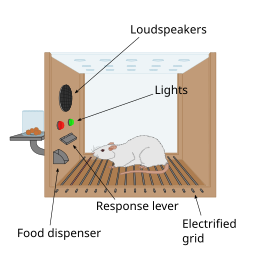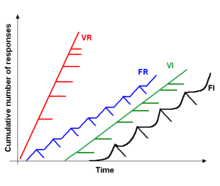Reinforcement
Consequences that lead to appetitive behavior such as subjective "wanting" and "liking" (desire and pleasure) function as rewards or positive reinforcement.The concept has been applied in a variety of practical areas, including parenting, coaching, therapy, self-help, education, and management.By contrast, technical parlance would use the term "negative reinforcement" to describe encouragement of a given behavior by creating a scenario in which an unpleasant factor is or will be present but engaging in the behavior results in either escaping from that factor or preventing its occurrence, as in Martin Seligman’s experiment involving dogs learning to avoid electric shocks.Accordingly, activities, foods or items considered pleasant or enjoyable may not necessarily be reinforcing (because they produce no increase in the response preceding them).Laboratory research on reinforcement is usually dated from the work of Edward Thorndike, known for his experiments with cats escaping from puzzle boxes.[10]: 252 The main difference is that reinforcement always increases the likelihood of a behavior (e.g., channel surfing while bored temporarily alleviated boredom; therefore, there will be more channel surfing while bored), whereas punishment decreases it (e.g., hangovers are an unpleasant stimulus, so people learn to avoid the behavior that led to that unpleasant stimulus).During a deliberate extinction, the targeted behavior spikes first (in an attempt to produce the expected, previously reinforced effects), and then declines over time.Example: Reading a book because it is fun and interestingExample: Corporal punishment, such as spanking a childExample: Loss of privileges (e.g., screen time or permission to attend a desired event) if a rule is brokenExample: Reading a book because it allows the reader to escape feelings of boredom or unhappiness A primary reinforcer, sometimes called an unconditioned reinforcer, is a stimulus that does not require pairing with a different stimulus in order to function as a reinforcer and most likely has obtained this function through the evolution and its role in species' survival.The behavior of opening the front door is rewarded by a big kiss on the lips by the person's spouse and a rip in the pants from the family dog jumping enthusiastically.An example is a rat that is given a food pellet immediately following the first response that occurs after two minutes has elapsed since the last lever press.In addition, ratio schedules can deliver reinforcement following fixed or variable number of behaviors by the individual organism.Brechner (1974, 1977) introduced the concept of superimposed schedules of reinforcement in an attempt to create a laboratory analogy of social traps, such as when humans overharvest their fisheries or tear down their rainforests.When shaping is combined with other evidence-based practices such as Functional Communication Training (FCT),[25] it can yield positive outcomes for human behavior.People's morning routines are a typical chain, with a series of behaviors (e.g. showering, drying off, getting dressed) occurring in sequence as a well learned habit.Challenging behaviors seen in individuals with autism and other related disabilities have successfully managed and maintained in studies using a scheduled of chained reinforcements.[30] Reinforcement and punishment are ubiquitous in human social interactions, and a great many applications of operant principles have been suggested and implemented.Positive and negative reinforcement play central roles in the development and maintenance of addiction and drug dependence.The brain's reward system assigns it incentive salience (i.e., it is "wanted" or "desired"),[31][32][33] so as an addiction develops, deprivation of the drug leads to craving.[31][32][33] These previously neutral stimuli acquire several properties: their appearance can induce craving, and they can become conditioned positive reinforcers of continued use.[35] In addition, parents learn to select simple behaviors as an initial focus and reward each of the small steps that their child achieves towards reaching a larger goal (this concept is called "successive approximations").This way, the student understands why they are receiving the praise, they can accept it, and eventually learn to continue the action that was earned by positive reinforcement.For example, using rewards or extra recess time might apply to some students more, whereas others might accept the enforcement by receiving stickers or check marks indicating praise.[37] As stated earlier in this article, a variable ratio schedule yields reinforcement after the emission of an unpredictable number of responses.Slot machines pay off on a variable ratio schedule, and they produce just this sort of persistent lever-pulling behavior in gamblers.Because the machines are programmed to pay out less money than they take in, the persistent slot-machine user invariably loses in the long run.[38] The concept of praise as a means of behavioral reinforcement in humans is rooted in B.F. Skinner's model of operant conditioning.[47][48] The other source indicated that [49] 'The necessary conditions for traumatic bonding are that one person must dominate the other and that the level of abuse chronically spikes and then subsides.The relationship is characterized by periods of permissive, compassionate, and even affectionate behavior from the dominant person, punctuated by intermittent episodes of intense abuse.Any threat to the balance of dominance and submission may be met with an escalating cycle of punishment ranging from seething intimidation to intensely violent outbursts.The practice has been tied to the same methods that slot machines and other gambling devices dole out rewards, as it follows a variable rate schedule.


Reinforcement (disambiguation)Operant conditioning chamberbehavioral psychologyantecedent stimulusoperant behavior"wanting" and "liking"operant conditioningbehavior modificationaddictionbiopsychosocialalcoholaddictive drugreward systemsdependencedrug sensitizationdrug withdrawalphysical dependencedelirium tremenspsychological dependencerewardingsensitizationsubstance use disordertoleranceMartin Seligman’sB.F. Skinnerbehaviorismreproduciblespecial educationapplied behavior analysisexperimental analysis of behaviorpsychopharmacologycompulsionEdward ThorndikeThe Behavior of Organismsbehavioral modificationExtinctionPunishmentPositive reinforcementNegative reinforcementPositive punishmentNegative punishmentEscapeActive avoidanceclassical conditioningpunishment (psychology)desirable event or stimulushigh probability instructionbehavioristaversive situation or stimuluschannel surfinghangoversAversiveCorporal punishmentspanking a childscreen timepairing with a different stimuluspairing with a stimulusmotivating operationsPremack principleDavid PremackcausalCharles Ferstertoken economypigeonspunishinggamblersslot machinespsychologyschedules of reinforcementpigeonsocial trapsoverharvestsocial trapenergysystemsapproach–avoidance conflictKurt Lewinforce field analysistwo-alternative forced choiceSkinner boxmatching lawR.J. HerrnsteinShaping (psychology)Chainingmathematical principles of reinforcementdrug dependenceintrinsically rewardingincentive saliencedrug paraphernaliarelapseself-administeredtremorsanhedoniaAnimal trainingParent management trainingprogress chartsBehavioral economicsConsumer demand tests (animals)GamblingPraiseTraumatic bondingcycles of abuseCompulsion loopvideo game addictionLoot boxmonetization of video gamesskin gamblingcirculardifferential outcomes effectBehavioral cuspDog trainingLearned industriousnessOverjustification effectPavlovian-instrumental transferReinforcement sensitivity theoryReward systemBibcodeThomson/WadsworthGamasutraEurogamerArizona State UniversityFerster CBSkinner BFWayback MachineCocaineNicotine